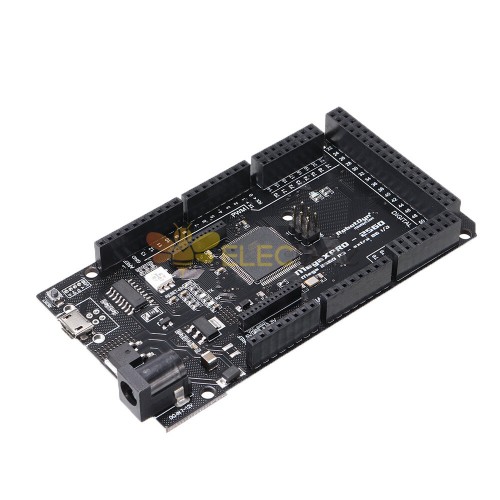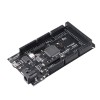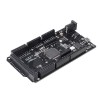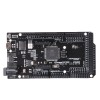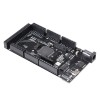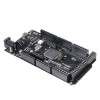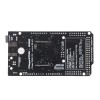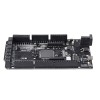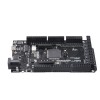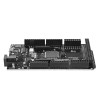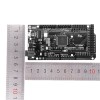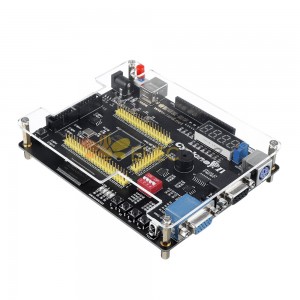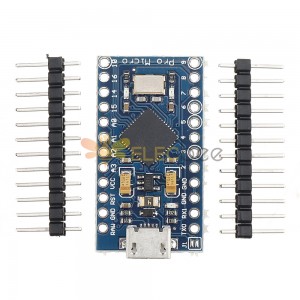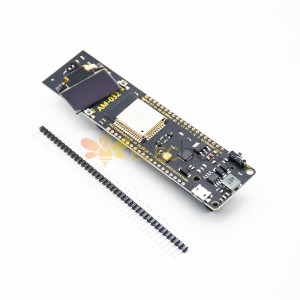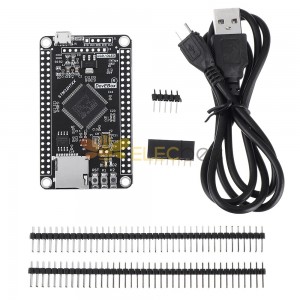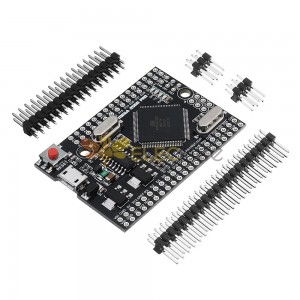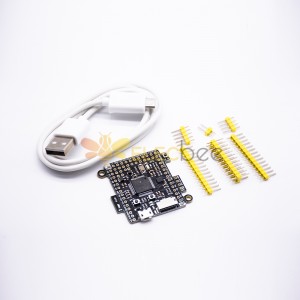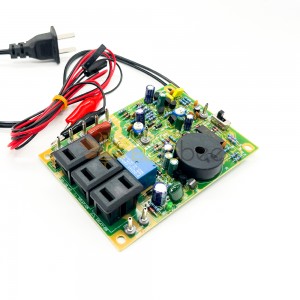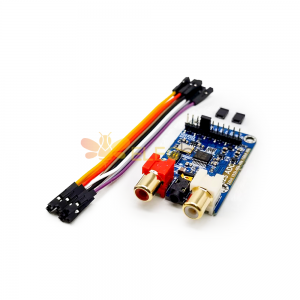The MegaXPRO R3 - Mega 2560 R3 is an extra I/O board, which is convenient to use for creating powerful projects with more functions.
With 86 I/O - 69 digital I/O pins, 17 analog inputs (YES, more pins unlike standard Arduino Mega 2560 with 70 I/O), 4 UARTs (hardware serial ports), one I2C and one SPI interface, and a larger memory space 256KB for your sketch1.
In addition, you can create a project with 3.3V or 5V logiclevel. Onboard has a solution for switch between 3.3V or 5V.
Just connect to your PC to USB and download the sketch1 from Arduino IDE.
MegaXPRO R3 - Mega 2560 R3 is open-source hardware, base on MCU ATmega2560! You can create your own projects or gadgets using the following files: schematic diagram, dimension diagram, pinout diagram, Eagle and Altium CAD library, datasheet, 3Dstep file, software library.
Programming:
The MegaXPRO R3 - Mega 2560 R3 controller can be programming with the Arduino(R) IDE software.
The MegaXPRO R3 - Mega 2560 R3 comes pre-installed with a bootloader for Arduino IDE, that allows you to upload new code to it without the use of an external hardware programmer. You can also direct program the microcontroller through the ICSP (In-Circuit Serial Programming).
Power:
The MegaXPRO R3 - Mega 2560 R3 can be powered via the USB connection or with an external power supply.
Note: The board has a resettable fuse that protects your computer's USB ports from shorts and overcurrent.
If more than 500 mA is applied to the USB port, the fuse will automatically break the connection until the short or overload is removed.
External power can come either from a DC adapter or battery to DC IN Jack or to VIN. The board can operate on an external supply:
TO VIN: of 7 to 12 volts.
TO 5V: 5V. (Logiclevel will be 5V, switch to 5V)
TO 3.3V: 3.3V. (Logiclevel will be 3.3V, switch to 3.3V)
TO VCC-IOREF: 5V (Logiclevel will be 3.3V) or 3.3V (Logiclevel will be 3.3V). In this case, power stabilizers will be disconnected and the board will use small power. The switch needs to be unsoldered connection. Details in the datasheet.
If to VIN supplied with less than 6.4V, however, the 5V pin may supply less than five volts and the board may become unstable. If using more than 12V to VIN, the voltage regulator may overheat and damage the board. The recommended range is 7~12 volts.Memory:
The ATmega2560 has 256 KB of flash memory for storing code (of which 8 KB is used for the bootloader), 8 KB of SRAM and 4 KB of EEPROM (which can be read and written with the EEPROM library).
Input and Output:
See the pinout diagram document.
MegaXPRO R3 - Mega 2560 R3 ports:
Each of the 70 digital pins on the MegaXPRO R3 - Mega 2560 R3 can be used as an input or output, using pinMode(), digitalWrite(), and digitalRead() functions. They operate at a voltage selected of the switch: Logiclevel. Each pin can provide or receive 20 mA as recommended operating condition and has an internal pull-up resistor (disconnected by default) of 20-50 k ohm. A maximum of 40mA is the value that must not be exceeded to avoid permanent damage to the microcontroller. In addition, some pins have specialized functions:
Serial: D0 (RX0) and D1 (TX0); Serial 1: D19 (RX1) and D18 (TX1); Serial 2: D17 (RX2) and D16 (TX2); Serial 3: D15 (RX3) and D14 (TX3). Used to receive (RX) and transmit (TX) TTL serial data. Pins D0 and D1 are also connected to the corresponding pins of the USB-UART Serial chip (ATmega16U2/ CP2104/ CH340C from a model of board).
External Interrupts: D2 (interrupt 0), D3 (interrupt 1), D18 (interrupt 5), D19 (interrupt 4), D20 (interrupt 3), and D21 (interrupt 2). These pins can be configured to trigger an interrupt on a low level, a rising or falling edge, or a change in level. See the attachInterrupt() function for details.
PWM: D2 to D13 and D44 to D46. Provide 8-bit PWM output with the analogWrite() function.
SPI: D50 (MISO), D51 (M0SI), D52 (SCK), D53 (SS). These pins support SPI communication using theSPI library. The SPI pins are also broken out on the ICSP header.
I2C (TWI): D20 (SDA) and D21 (SCL). Support TWI communication using the Wire library.
Analog IN: The MegaXPRO R3 - Mega 2560 R3 has 17 analog inputs, each of which provides 10 bits of resolution (i.e. 1024 different values). By default, they measure from ground to power level (5/3.3 volts), though is it possible to change the upper end of their range using the AREF pin and analogReference() function.
There are a couple of other pins on the board:
AREF: The reference voltage for the analog inputs. Used with analogReference().
Reset: Bring this line LOW to reset the microcontroller. Typically used to add a reset button to shields which block the one on the board.Communication:
The MCU-PRO Mega 2560 controller has a number of facilities for communicating with a PC, other digital boards, or other microcontrollers. The MCU ATmega2560 provides four hardware UARTs for TTL serial communication. A USB-UART on the board channels one of these over USB and provides a virtual com port to software on the PC (OS will recognize the board as a COM port automatically). The Arduino IDE Software includes a serial monitor which allows simple textual data to be sent to and from the board. The RX and TX LEDs on the board will flash when data is being transmitted via the USB-UART chip and USB connection to the PC (but not for serial communication on pins D0 and D1). The MegaXPRO R3 - Mega 2560 R3 also supports I2C(TWI) and SPI communication. The Arduino IDE Software includes a Wire library to simplify the use of the I2C(TWI) bus. For SPI communication, use the SPI library.
USB:
The MegaXPRO R3 - Mega 2560 R3 have micro USB for connecting to PC, also on board have 4 pinouts for connecting the external USB cable or USB socket.
LED RGB:
The MegaXPRO R3 - Mega 2560 R3 have RGB LED connected to D11, D12, D13.| Microcontroller | ATmega2560 |
| USB-TTL converter | CP2104 |
| Power Out | 5V-800mA, 3.3V-800mA |
| Power IN USB. | USB 5V |
| Power IN. VIN | VIN 7~9V |
| Power Consumption | 120mA |
| LogicLevel | 5V/3.3V |
| USB | Micro USB / USB-B |
| Clock Frequency | 16MHz |
| Operating Supply Voltage | 5V/3.3V |
| Digital I/O | 69 |
| Analog I/O | 17 |
| Memory Size | 256kb |
| Data RAM Type/Size | 8Kb |
| Data ROM Type/Size | 4Kb |
| Interface Type | ISP, I2C, UART, USB |
| Operating temperature | −40С°/+85С° |
| Form-factor | Arduino Mega R3 |
Documents:
Tutorial: Click here to open

